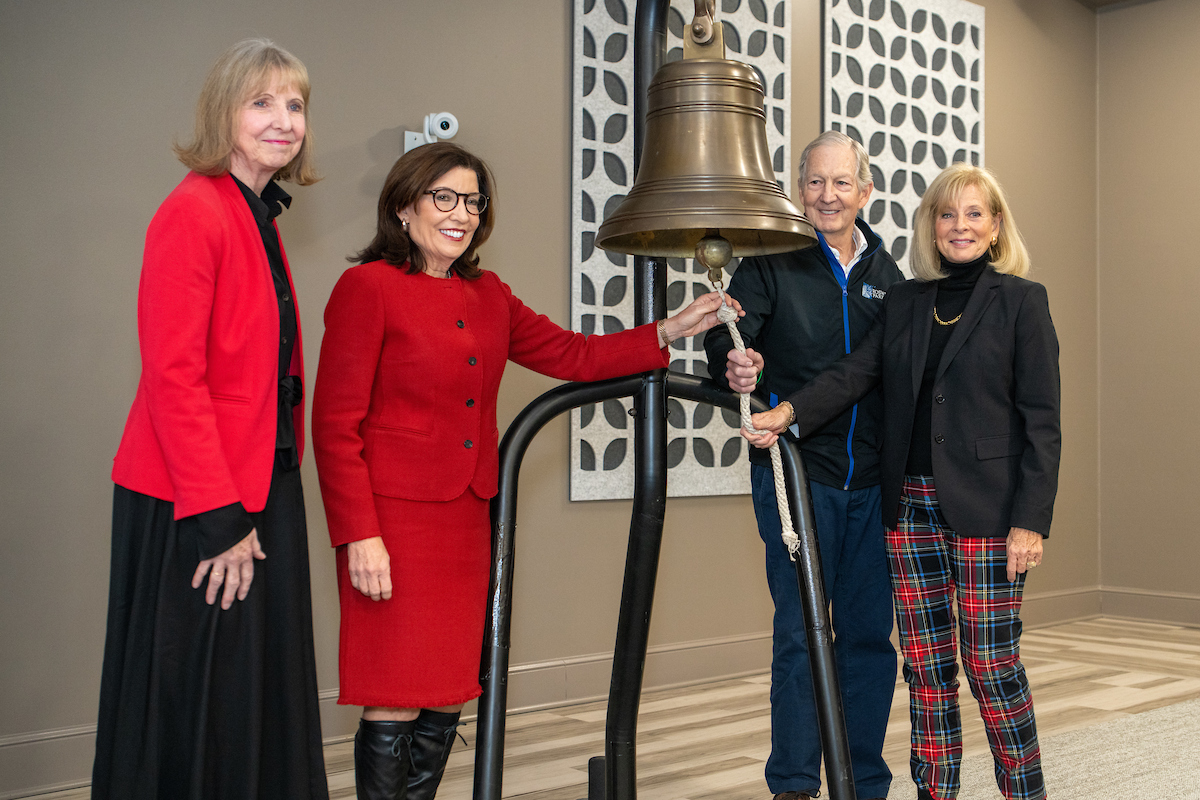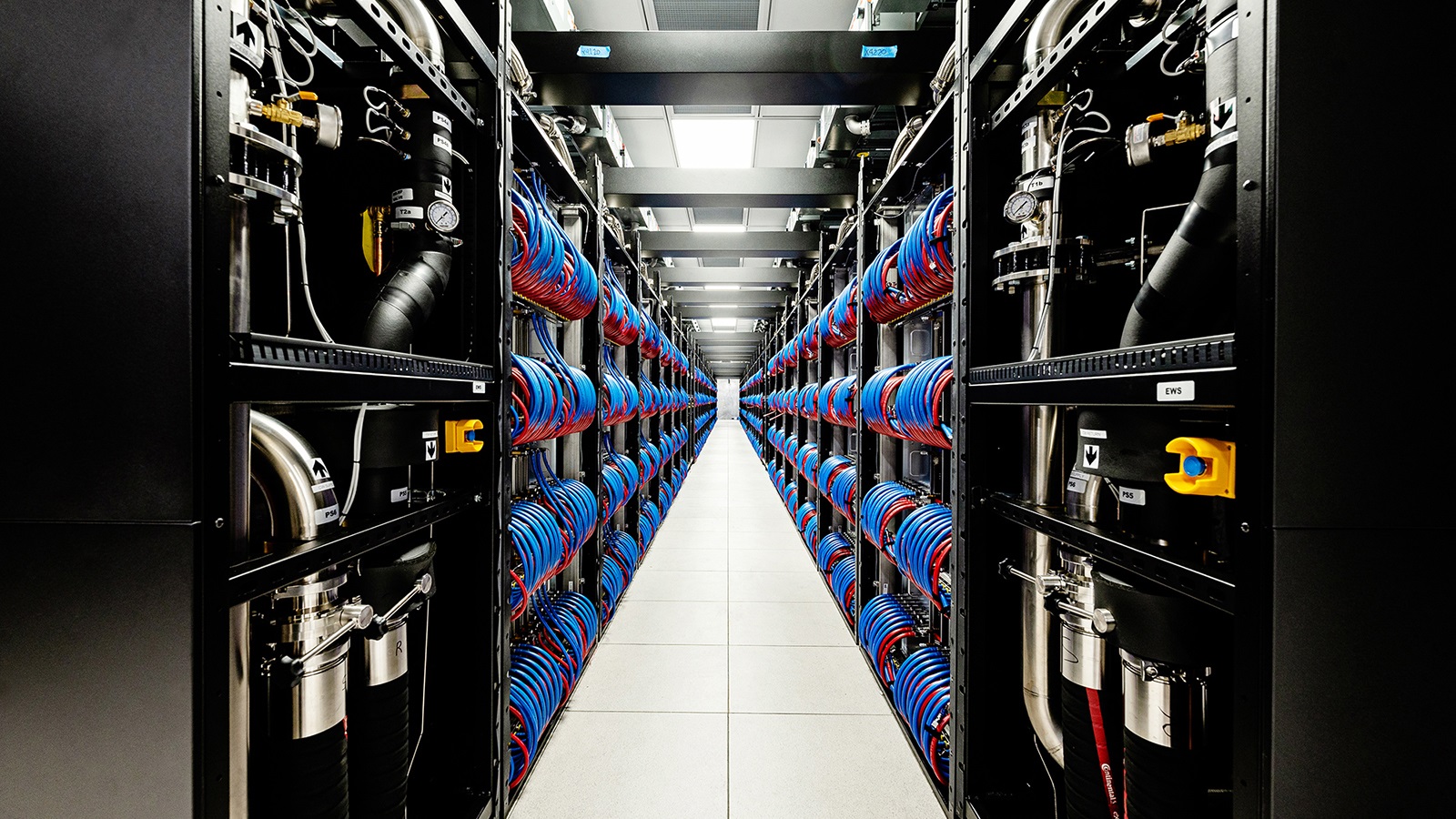That’s a lab-scale wind turbine, said Luis Guillén Montenegro from Ecuador and Hoang Dang from Vietnam, two doctoral students in electrical and computer engineering, as they led a recent tour of the lab.
The small-scale turbine – when connected to the lab’s collection of controllers, emulators, inverters, converters, capacitors, sensors and cables, all the tools of power electronics – can validate computer simulations of power grid operations.
What happens when a storm blows through and the grid goes down? Can wind turbines help restore that grid? If that works, how can it be controlled? How to account for the variability of wind? And what happens to the process if lightning strikes a transmission line and causes a grid fault?
The lab and those questions are all part of Iowa State’s Electric Power Research Center (EPRC), now in its 60th year. The center is all about supporting research, connecting university researchers with industry engineers and launching students into electric power careers.
The center’s director, Anne Kimber, remembers a leader of the U.S. Department of Energy’s National Renewable Energy Laboratory looking over research posters describing the center’s projects. And that leader said it was good to see the center addressing the really hard questions in electric power.
Dang, for example, is figuring out how to restore a power grid after a natural disaster by using the power from variable, renewable sources. And Guillén Montenegro is studying how to use solar power to quickly charge electric vehicles.
Which ideas will stick?
The Electric Power Research Center began in 1963 as the Power Affiliates Program. Its mission was to “advance research and graduate education in electric power systems and strengthen industry ties.”
That mission still holds. The center has 10 industry members and three collaborators – including city utilities, power cooperatives, utility companies, a manufacturer of electrification equipment, a transmission company and a grid operator.
Kimber, who worked for the Iowa Association of Municipal Utilities for 14 years before joining the university center in 2014, said she enjoys connecting the two worlds.
When they’re brought together, the university researchers and the industry engineers will throw around ideas for research and development.
“That’s so exciting,” Kimber said. “The industry engineers know the problems in the field that we can’t know about.”
But once they do, Iowa State researchers can start looking for solutions.
Need some ideas for building up the Midwest’s electric infrastructure so it can withstand high winds, such as the August 2020 derecho that hit wind speeds up to 140 mph across 23 Iowa counties and parts of eight other states? Talk to James McCalley.
McCalley, an Anson Marston Distinguished Professor in Engineering and Jack London Chair in Power Systems Engineering, is part of a new, $17.8 million national university research consortium supported by the Department of Energy.
Called EARNEST (An Equitable, Affordable & Resilient Nationwide Energy System Transition) and led by Inês Azevedo of Stanford University in California, the consortium will study ways to improve grid resiliency, establish decarbonization goals across North America and prioritize the investments needed to achieve those goals, according to an energy department announcement.
Researchers from Iowa State and Argonne National Laboratory in Illinois will use about $1 million from the project to identify effective, low-cost strategies to help electric infrastructure in Iowa and the Midwest survive windstorms.
“What can we do with infrastructure to reduce impacts and recover more quickly?” McCalley said. “How do you harden that infrastructure?”
Find those answers, he said, and maybe a 75-mph windstorm that can take out big, long-distance transmission lines today won’t take them out in the future.
And maybe that means Midwesterners deal with fewer billion-dollar wind events. (That 2020 derecho? Damages cost an estimated $12.8 billion, according to the National Centers for Environmental Information.
Inventing to meet industry needs
Dehn Stevens, working as an Electric Power Research Center research assistant in 1990 and 1991 while pursuing an undergraduate degree in electrical engineering, measured and modeled the electric and magnetic fields (EMFs) from power lines. There were concerns at the time that the fields could cause cancer, prompting research to document field levels from various types of electric equipment.
“To this day, I still get questions about EMFs,” said Stevens, who’s now MidAmerican Energy’s vice president – transmission development and planning. (Further research has found weak to no evidence that power lines cause cancers.)
All these years later, Stevens is still working with the research center. Though now he’s on the industry side of the studies.
“I think we get a lot of value from the EPRC,” Stevens said. “There’s a lot of value in supporting research and supporting graduate students.”
On the research side, Stevens said the center provides “a meaningful connection between research and industry” that allows for “real-world applications.” On the education side, “we see it as a pipeline for future personnel.”
And, he said it’s great to see industry’s support for the center multiply when Iowa State researchers win grants from the Department of Energy and other agencies. That’s especially true when those research projects involve wind energy – the company generated 88.5% of the electricity delivered to Iowa customers from wind turbines in 2021.
Hugo Villegas Pico is one of those wind-energy researchers. Get him on a Zoom call and the Harpole-Pentair Assistant Professor of electrical and computer engineering will work his way through a list of projects and papers dealing with renewable energy on the grid.
First up is a three-year, $729,349 energy department study of how power grids can be restored after a blackout with the electricity supplied by wind power plants. That’s the study Dang, one of the doctoral students in Villegas Pico’s group, has been working on.
A key to that process is developing the step-by-step computer algorithms for the controllers running the restart process, a process called “black start” by engineers. And it’s something industry needs as more and more wind power is added to the grid. (Wind turbines are now the biggest source of Iowa’s electricity, generating 64% of the state’s supply in 2022.)
Dang calls those controllers “the brains of the operations.”
They’re run from gray “real-time simulator” boxes about the size of a desktop computer. Data is fed into the controllers, processed and then appropriate commands are sent to the grid.
“We invented these at Iowa State,” Villegas Pico said. “These controllers are our proposed solution to the problem of restoring a wind-dominant grid.”
The Electric Power Research Center is critical for those kinds of studies, Villegas Pico said.
“The center connects academics with industry,” he said. “They know what the real problems are. That makes our research realistic and useful.”
Electrifying the economy
Electrification is a key path to progress in fighting climate change, according to a 2021 report by President Joe Biden’s administration. The report proposed a long-term strategy for the United States to reach net-zero greenhouse gas emissions by 2050.
“We can affordably and efficiently electrify most of the economy, from cars to buildings and
industrial processes,” says the report.
And what about this idea of electrifying everything? Does that mean bright days ahead for the Electric Power Research Center as it continues 60 years of connecting industry with Iowa State researchers and graduate students?
“To us, right now in this moment of history,” said Kimber, the center’s director, “it’s the most exciting time in the world.”
– 30 –



